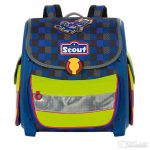No matter in what form – as pedestrians, cyclists or vehicle occupants – children are particularly at risk in road traffic because in the event of an accident they are often injured the most.
Here the parents are required not only to ensure early traffic education, but also to ensure proper safety while driving. Children up to the age of twelve who are shorter than 1.50 meters must always be secured with special seating systems tailored to their size. Because a normal three-point belt, suitable for an adult, is not enough for the little ones.
The first paragraph of the Road Traffic Act reads “Participation in road traffic requires constant caution and mutual consideration“. It is no coincidence that this paragraph is right at the beginning of the road traffic regulations. It demands a high degree of responsibility from everyone who takes part in road traffic. Especially towards the weaker ones who cannot yet take responsibility themselves: our children.
Due to the small body size, it runs along the neck and across the stomach instead of over the shoulder and pelvis. Even a minor impact can result in injury. In the event of a serious accident, the wrong position of the seat belt can even lead to strangulation of the child.
The prescribed devices are divided into classes 0 to III and are based on age and weight. It is important that the belt is always as tight and close to the child’s body as possible. Likewise, the child seat must be checked regularly and, if necessary, readjusted to the growing offspring. Legal guardians should also look out for the ECE R 44/03 or 44/04 sign, because since April 2008 only systems marked in this way have been officially approved.
Traffic education from an early age: The Federal Ministry BMVI offers projects to educate children and improve road safety. For example, the Käpt’n Blaubär traffic primer, which you can also order for your child. With the help of stories and riddles, the brochure playfully conveys the safe handling of important traffic rules. So that your child can move safely in traffic. You should also pay attention to the following points:
Highly visible reflective vests

You should always have a reflective vest for children with you in the car. Even when the youngsters are out and about by bike, the reflective strips and the fluorescent fabric ensure that your child is noticed by other road users in good time. The vest is very light and breathable and can therefore be worn every day on the way to school. Also make sure that your child knows the way to school well. It is best to walk the way to school with the child before the first day of school and explain what to look out for, for example at zebra crossings or traffic lights. The school backpack for smaller children should also be equipped with appropriate reflectors so that the children are clearly visible to other road users. Take a look around here with your child for a suitable school bag.
Child seat by size
A good child car seat must offer your child enough space so that it is not restricted. But it must also provide sufficient support. For the best fit, the height and weight of your child should be taken into account. The manufacturers indicate the size of a seat in standard groups. The best thing to do is get advice from a professional in the shop. You can also get an initial overview of the different seat types and sizes on the Internet. Trying it out should happen without thick winter clothing or a footmuff. Otherwise the height and stature of the child can change and the seat would not be correctly adjusted to the child.
Buckle up kids in the car
Up to a height of 1.50 meters or an age of 12 years, children must be buckled into a seat in the car. According to ADAC, the best place is on the back seat in the middle. If this is occupied, children should sit on the right side so they can exit or be taken out on the sidewalk side. Typical mistakes that are often made when buckling the child in the seat can easily be avoided, you should pay attention to the following:
- Make sure the belt is tight. As a rule of thumb, an adult hand should fit between the harness and the child.
- The three-point belt should go over the middle of the child’s shoulder.
- The child’s head should be within the headrest (even when the child is sleeping).
But even if a child is older or big enough and no longer needs a seat, it is best to explain how to buckle up properly and how important it is (even if it is not your child). Don’t rely on the young passengers. Take responsibility and make sure before each journey that any children traveling with you have remembered to fasten their seat belts.
